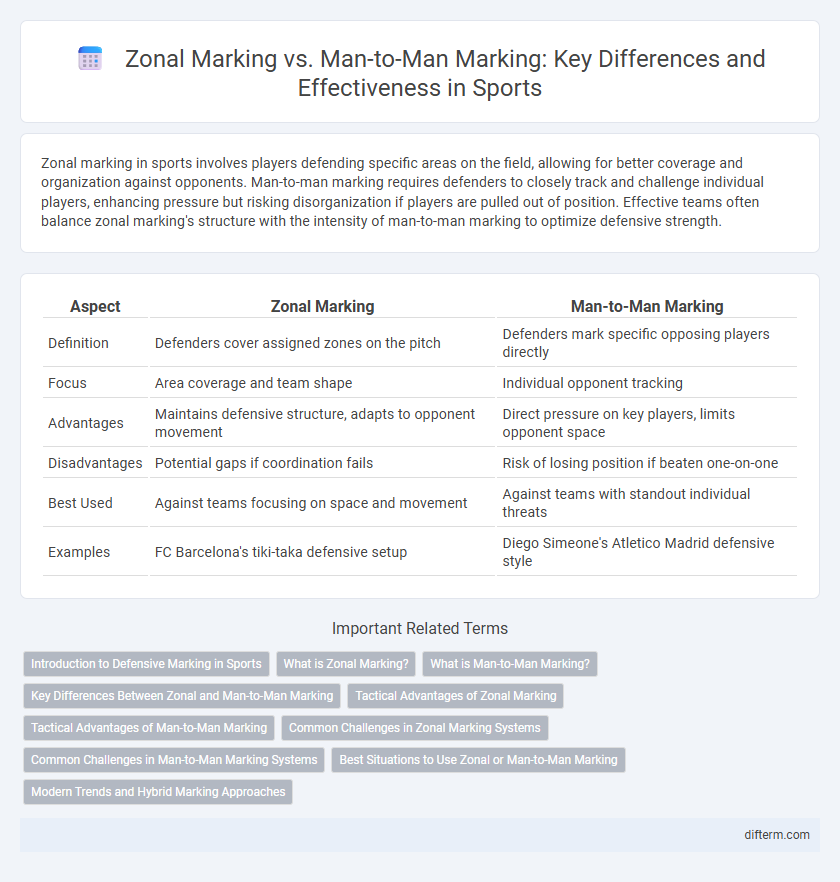Zonal marking in sports involves players defending specific areas on the field, allowing for better coverage and organization against opponents. Man-to-man marking requires defenders to closely track and challenge individual players, enhancing pressure but risking disorganization if players are pulled out of position. Effective teams often balance zonal marking's structure with the intensity of man-to-man marking to optimize defensive strength.
Table of Comparison
| Aspect | Zonal Marking | Man-to-Man Marking |
|---|---|---|
| Definition | Defenders cover assigned zones on the pitch | Defenders mark specific opposing players directly |
| Focus | Area coverage and team shape | Individual opponent tracking |
| Advantages | Maintains defensive structure, adapts to opponent movement | Direct pressure on key players, limits opponent space |
| Disadvantages | Potential gaps if coordination fails | Risk of losing position if beaten one-on-one |
| Best Used | Against teams focusing on space and movement | Against teams with standout individual threats |
| Examples | FC Barcelona's tiki-taka defensive setup | Diego Simeone's Atletico Madrid defensive style |
Introduction to Defensive Marking in Sports
Zonal marking organizes defenders to cover specific areas, ensuring spatial control and reducing gaps for the attacking team. Man-to-man marking assigns players to track individual opponents closely, enhancing pressure on key attackers and limiting their space. Effective defensive strategies often blend zonal and man-to-man marking to maximize team cohesion and adaptability.
What is Zonal Marking?
Zonal marking in sports is a defensive strategy where each player is assigned a specific area of the field to cover rather than marking a specific opponent. This method emphasizes spatial control and collective team organization to prevent the opposing team from exploiting gaps. It is commonly used in soccer and basketball to maintain defensive shape and reduce vulnerability to individual dribbling or movement.
What is Man-to-Man Marking?
Man-to-man marking is a defensive strategy in sports where each player is assigned to closely guard a specific opponent, restricting their space and influence on the game. This technique requires high levels of concentration, stamina, and tactical awareness, as defenders must anticipate and mirror the movements of their assigned players. By limiting individual threats, man-to-man marking aims to disrupt offensive plays and reduce scoring opportunities.
Key Differences Between Zonal and Man-to-Man Marking
Zonal marking assigns defenders to specific areas of the field, ensuring coverage of space and multiple attacking players entering that zone, which enhances team organization and reduces vulnerability to off-the-ball movements. Man-to-man marking requires defenders to closely track individual opponents throughout the match, increasing physical demands and necessitating high levels of concentration and stamina. Key differences include zonal marking's emphasis on spatial awareness and collective responsibility versus man-to-man's focus on individual accountability and tight player engagement.
Tactical Advantages of Zonal Marking
Zonal marking enhances defensive organization by assigning players to specific areas, reducing vulnerabilities to quick positional changes and off-the-ball runs. It facilitates better spatial coverage, allowing teams to control the game tempo and intercept passes more effectively. This approach also minimizes fatigue by preventing constant individual chases, preserving energy for crucial moments in the match.
Tactical Advantages of Man-to-Man Marking
Man-to-man marking offers precise defensive control by assigning each defender to a specific opponent, reducing the risk of unmarked attackers exploiting space. This tactical approach enhances accountability and allows defenders to closely track opponents' movements, disrupting passing lanes and attacking rhythms. Teams employing man-to-man marking benefit from increased pressure on key players, which can limit creativity and force errors within the opposing team's offensive structure.
Common Challenges in Zonal Marking Systems
Zonal marking systems often face challenges such as communication breakdowns among defenders, leading to gaps exploited by opponents. Players may struggle with identifying when to pass on marking responsibilities during opponent movements, causing confusion. Additionally, zonal marking can be vulnerable to well-coordinated runs that disrupt the defensive shape and create scoring opportunities.
Common Challenges in Man-to-Man Marking Systems
Man-to-man marking systems often face challenges such as increased physical and mental demand on players to consistently track opponents, leading to fatigue and lapses in concentration. Defenders may struggle against agile or skillful attackers who exploit mismatches or create confusion through movements and positioning. Communication breakdowns and lack of coordinated support can expose defensive vulnerabilities, making it easier for opponents to penetrate and create goal-scoring opportunities.
Best Situations to Use Zonal or Man-to-Man Marking
Zonal marking excels in defending set-pieces and managing spaces against teams with fluid attacking patterns, allowing players to cover dangerous areas rather than follow individual opponents. Man-to-man marking proves most effective when neutralizing key playmakers or physically dominant opponents, ensuring tight containment and disruption of their influence. Coaches often deploy zonal marking in well-organized defensive units during open play while opting for man-to-man marking in high-pressure scenarios requiring individual accountability.
Modern Trends and Hybrid Marking Approaches
Modern football tactics increasingly favor hybrid marking approaches that combine zonal and man-to-man marking to enhance defensive flexibility and adaptability. Coaches deploy zonal marking to maintain team shape and cover strategic spaces while integrating man-to-man assignments to neutralize key opposition players effectively. Tactical innovations like these optimize defensive organization, responding dynamically to game scenarios and evolving positional roles.
zonal marking vs man-to-man marking Infographic

 difterm.com
difterm.com